
Features
Agronomy
Insect Pests
Insect update and forecast 2015
The grasshopper risk has been increasing in southern Alberta for the last few years. Photo by Janet Kanters.
Weather gave farmers a helping hand in 2014, with few serious outbreaks from insects like diamondback moth, wheat midge and grasshopper.
Pests of all crops
Cutworm
After a three-year decline in numbers, there was an apparent resurgence in cutworm populations across Saskatchewan, according to Scott Hartley, provincial insect specialist with the Saskatchewan Ministry of Agriculture. He says controls were required, with instances of more than 30 acres impacted on some fields.
John Gavloski, entomologist with Manitoba Agriculture, Food and Rural Development, reports high populations of cutworms were reported in central Manitoba on cereal crops. Cutworm damage was also reported on corn in the eastern and central regions of the province and some spraying was done. Cutworms were also sprayed on some canola, sunflower and dry bean fields.
Cutworm problems were not reported in Alberta.
Methods for predicting cutworm infestations do not exist, so forecasts for 2015 are not reliable. Cutworms tend to be more problematic in warm, dry springs, but not necessarily for all species of cutworms.
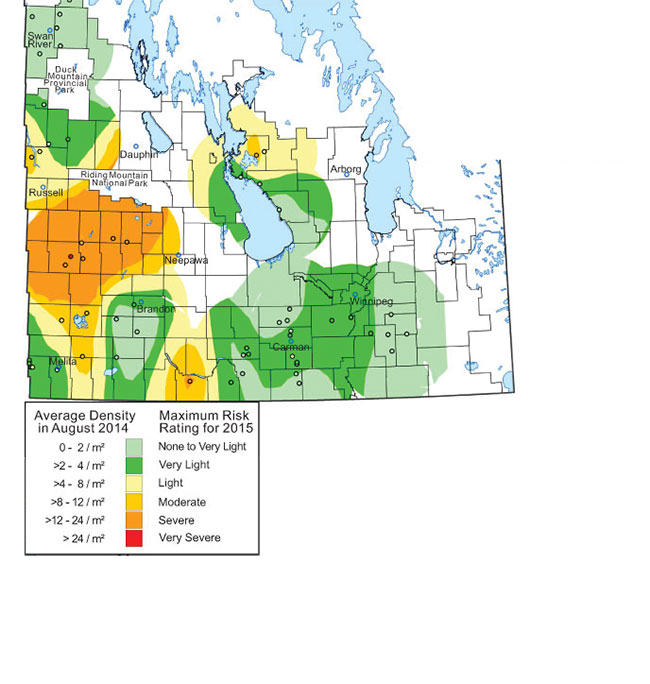 |
| Manitoba Grasshopper forecast 2015 |
Grasshopper
The risk of economically significant grasshopper populations in 2015 has increased in parts of southern Alberta and decreased in central Alberta and the Peace region. The grasshopper risk has been increasing in southern Alberta for the last few years and the provincial survey shows there are now some high-risk areas for 2015. The most notable increase in grasshopper populations in southern Alberta are in Forty Mile and Willow Creek counties.
“In southern Alberta, if perfect conditions for grasshoppers occur in 2015, you may have to spray,” Scott Meers, insect management specialist with Alberta Agriculture and Rural Development, says.
Economic infestations of grasshopper were reported in Saskatchewan in only a few areas in the southwest, around Leader, Richmound and Fox Valley, with only one report from the south central Region. The Saskatchewan 2015 grasshopper forecast shows pockets of very light risk, mainly in southern Saskatchewan.
In Manitoba, Gavloski says grasshopper populations have been increasing over the last three years, and in 2014 there was a further trend to more areas in the higher risk categories. The risk of economical populations of grasshoppers developing in 2015 is quite variable, depending on location, with some areas in western Manitoba having moderate to severe risk (see map above).
Canola pests
Flea beetles
Despite common use of seed treatments to control flea beetles, Gavloski says feeding damage to canola at or above threshold levels, and additional use of foliar insecticides, was still reported from all agricultural regions of Manitoba. There were reports of some fields being sprayed two to three times, and some canola fields in eastern Manitoba were reseeded. He says several fields in central Manitoba were reseeded due to heavy damage from flea beetles or a combination of flea beetle and cutworm damage.
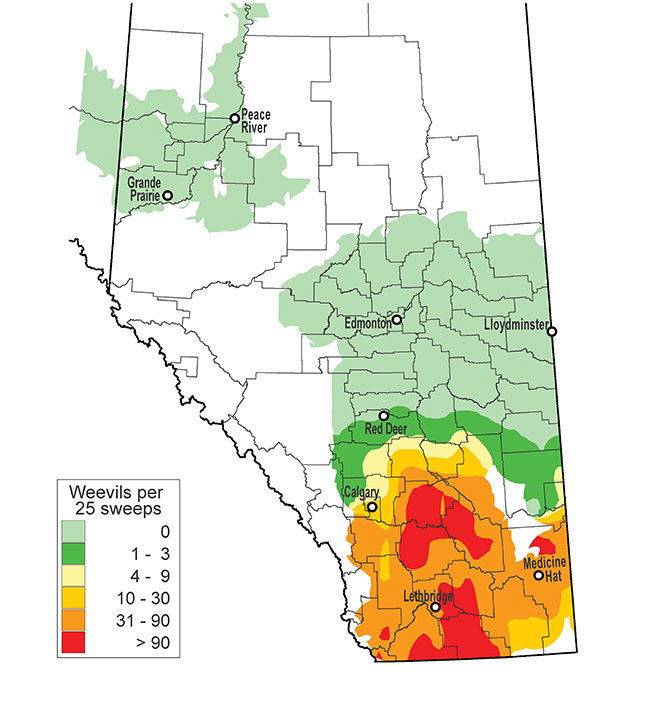 |
| Alberta Cabbage Seedpod Weevil 2014 Survey |
Cabbage seedpod weevil
The 2014 cabbage seedpod weevil survey covered all the canola growing areas of Alberta with 290 fields sampled in 49 municipalities (see map above, at right). The cabbage seedpod weevil is still only found at economic levels in southern Alberta. The Municipal District of Pincher Creek was added to the survey in 2014 and economic levels of cabbage seedpod weevil were found there.
Generally, weevil numbers were lower than in previous years in southern Alberta and there was less spraying than in a typical year. Unfortunately this does not necessarily mean cabbage seedpod weevil numbers will stay low in future years. It will be important to scout fields as they come into flower in 2015.
The range of economic levels did not expand in 2014 but the northern range of the weevil did appear to push further north to the southern boundaries of Red Deer, Stettler, Paintearth and Provost counties, notes Meers. “We’ve seen this push up there before and then the populations backed off. We will need to continue to monitor up in that region.”
Canola producers in southern Alberta and in the southern portion of central Alberta should scout for the insect as the crop comes into flower. The earliest flowering canola crops tend to have the highest risk from cabbage seedpod weevil and should be monitored very closely.
In Saskatchewan, Hartley says the cabbage seedpod weevil was at economic levels from the Alberta border to areas near Indian Head in southern Saskatchewan. Significant numbers were noted in the 2014 survey as far north as Kindersley in the west central region across to Outlook, but not necessarily corresponding with reports of spraying. “There is concern as the weevil is now into new areas where there is more extensive canola acreage,” Hartley says.
Diamondback moth
Diamondback moth blows in every year from the U.S. and is monitored with sentinel sites. In Saskatchewan, some higher counts were found in traps in June (Riverhurst and Yorkton), but that did not translate into economic infestations and spraying.
In Alberta, spraying occurred in Forty Mile County with high numbers at early flower in canola and with many acres above threshold.
Levels of diamondback moth were generally not economical in Manitoba, although a few fields in eastern Manitoba were sprayed.
Bertha armyworm
The bertha armyworm population in Alberta appears to have shifted west and south in 2014. This is likely due to diseases and parasitism in the previous outbreak areas in east central Alberta. There was much less spraying for bertha armyworm in Alberta in 2014 than in the previous two years. There was some need for treatment in Stettler and Leduc counties, and an outbreak centered around Foremost in southern Alberta resulted in between 20,000 and 30,000 acres sprayed.
The trend in Alberta appears to be higher populations in west central and southern Alberta, but 2015 populations will depend on overwinter survival and spring environmental conditions. With the amount of armyworm disease present, Meers says if weather conditions are favourable there may be a complete
collapse of the population in central Alberta in 2015.
Hartley says bertha armyworm continued to decline in Saskatchewan in 2014, and it is thought to be of a lesser risk for 2015. A few areas in southern Saskatchewan reported spraying in 2014.
In Manitoba, levels were generally low.
Swede midge
Swede midge was first identified in 2007 in northeast and east central Saskatchewan. The first significant infestations were noted in 2012 and 2013 around Nipawin and Carrot River, and west towards Humboldt. In 2014 an Agriculture and Agri-Food Canada survey indicated wider distribution of swede midge than previously known, including a new site near North Battleford.
In Manitoba, an individual swede midge was found in pheromone-baited traps in two instances at Sanford, and one instance at Winkler and Dauphin. Larvae were also found in a canola field northeast of Bowsman.
No swede midge has been reported in Alberta.
Swede midge remains on the watch list for entomologists on the Prairies. High or potentially economic levels have not been documented.
Cereal pests
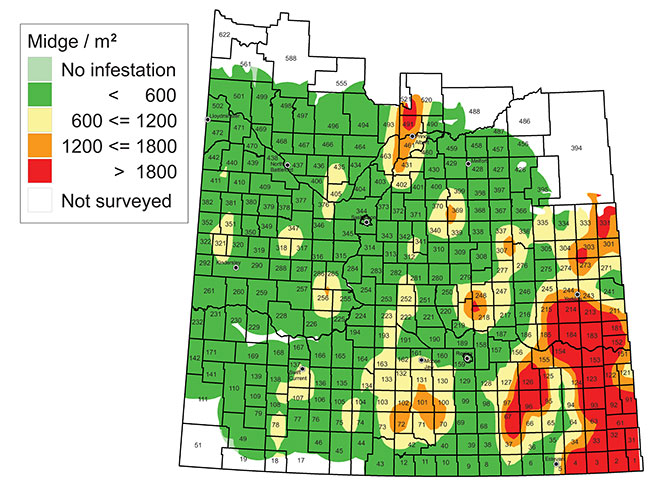 |
| Saskatchewan Wheat Midge Forecast 2015 |
Wheat midge
The Alberta wheat midge forecast for 2015 shows a collapse of the extreme populations in the eastern Peace Region, but wheat midge has not followed forecasts very well in that area, so caution needs to be observed. Central Alberta has shown a general increase in wheat midge risk with several areas of particular concern east of Edmonton.
The population has fallen to very low numbers in much of southern Alberta with the exception of some irrigated fields in the County of Forty Mile.
“Irrigated wheat in southern Alberta provides perfect conditions for wheat midge and we’ve seen some substantial yield loss,” Meers says. “Use good rotations and proper agronomy to help control midge there.”
Wheat midge populations were low in Saskatchewan in 2014. The 2015 wheat midge forecast for Saskatchewan shows the eastern part of the province has the highest risk (see map on page 19).
In Manitoba, Gavloski reports wheat midge was not a major concern in 2014, and wheat was already flowering in many areas by the time the pest emerged.
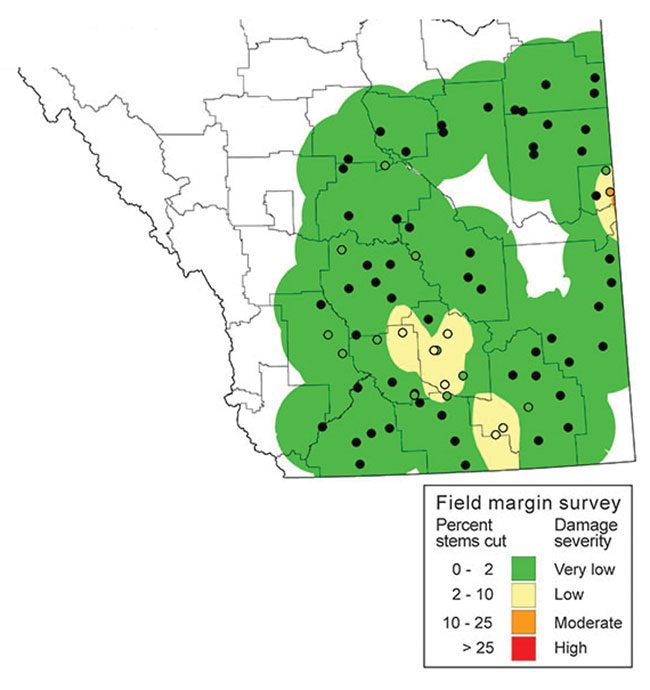 |
| Alberta Wheat Stem Sawfly 2014 Survey |
Wheat stem sawfly
The area at risk of economically significant wheat stem sawfly populations in 2015 will be limited to only a few areas in Alberta. The 2014 field margin survey shows low populations in most of the area surveyed, including the traditional sawfly areas in the Special Areas and the County of Forty Mile (see map above).
“Unless you’re in the County of 40 Mile, you probably won’t have a problem,” Meers notes.
Cereal leaf beetle
Meers says while cereal leaf beetle has been showing up in southern Alberta, he isn’t very concerned about it at this point. Threshold appears to be one beetle per flag leaf. “It hasn’t been causing economic damage. Natural enemies appear to be doing their job on cereal leaf beetle.”
In Manitoba, the range of cereal leaf beetle has expanded south and further east through the central region, although no populations have come close to economic thresholds. In 2014, cereal leaf beetle larvae were found in fields near Pilot Mound, LaRiviere and Roseisle. Two shipments of the parasitoid Tetrastichus julis were released in July and September in the hopes of establishing the parasitic wasp to help keep the cereal leaf beetle below economic levels.
European corn borer
Gavloski says higher populations of European corn borer were found in the central region of Manitoba with some insecticidal applications occurring.
Field pea
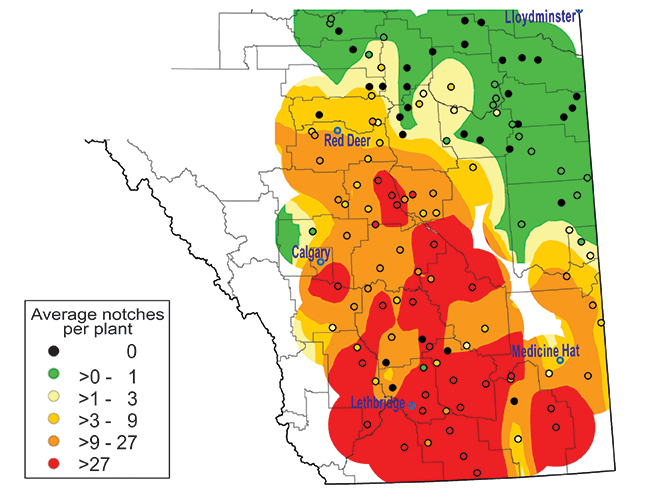 |
| Alberta Pea Leaf Weevil 2014 |
Pea leaf weevil
Damage from pea leaf weevil in Alberta in 2014 was much higher than in 2013, especially in southern Alberta (see map above). For producers south of Highway 1 and including the counties of Kneehill, Wheatland, Newell and Cypress, there is risk of damaging levels of pea leaf weevil in 2015. The areas in northern Wheatland County and Kneehill County have not previously seen such high populations of pea leaf weevil.
“We have never had more than 81 notches per plant, so damage was much higher in 2014,” Meers says. “There was an expansion in intensity north of Red Deer and I think this is connected to fababean. Pea leaf weevil really likes fababean.”
Meers notes the true economic damage of this insect on both peas and fababean on the higher organic matter soils of central Alberta is not well understood.
Some very low levels of feeding damage were once again found throughout central Alberta. This damage is so low that there is no risk of serious issues with pea leaf weevil throughout central Alberta in 2015. This is the same as in previous years and, despite range expansion, the damage rating numbers are still exceedingly low. It will be important to watch the development of these populations over the next few years.
The pea leaf weevil survey in Saskatchewan in 2014 suggested lower levels of the insect compared to 2013. Damage is still noted primarily in the southwest part of Saskatchewan, although some feeding was noted on pea in a few fields near Kyle, north of the South Saskatchewan River in 2013.
Pea leaf weevil does not occur in Manitoba.
On the horizon for 2015 and beyond, Meers says two crops will need to be watched carefully – hemp and fababean. “Bertha armyworm and lygus bug will become problems in hemp. Insects really like it,” Meers says.
April 28, 2015 By Bruce Barker